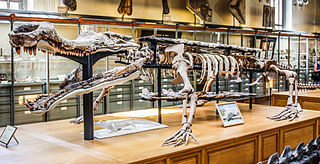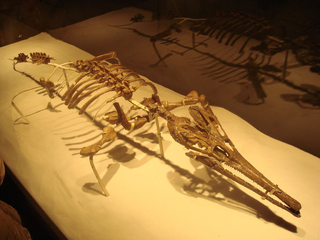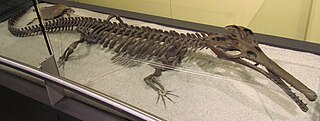
Sarcosuchus is an extinct genus of crocodyliform and distant relative of living crocodylians that lived during the Early Cretaceous, from the late Hauterivian to the early Albian, 133 to 112 million years ago of what is now Africa and South America. It was one of the largest crocodile-line reptiles, reaching an average estimate of 9 m (30 ft) and 3.5 metric tons, but estimated to grow up to 9.5 m (31 ft) in body length and weigh up to 4.3 metric tons. It is known from two species, S. imperator from the early Albian Elrhaz Formation of Niger and S. hartti from the Late Hauterivian of northeastern Brazil, other material is known from Morocco and Tunisia and possibly Libya and Mali.

Choristodera is an extinct order of semiaquatic diapsid reptiles that ranged from the Middle Jurassic, or possibly Triassic, to the late Miocene. Choristoderes are morphologically diverse, with the best known members being the gharial-like neochoristoderes such as Champsosaurus. Other choristoderans had lizard-like or long necked morphologies. Choristoderes appear to have been confined to the Northern Hemisphere, having been found in North America, Asia, and Europe, and possibly also North Africa. Cladists have placed choristoderes as neodiapsids, but the exact phylogenetic position of Choristodera is still uncertain. It has been proposed that they represent basal lepidosauromorphs or archosauromorphs.
Taveirosaurus (tah-VAY-roo-SAWR-us) is a genus of ornithischian dinosaur that lived in Europe during the Late Cretaceous. The genus is based solely on teeth.

Chimaerasuchidae is a family of mesoeucrocodylians. It was erected as a clade in 2004 by Carvalho et al and included Chimaerasuchus from the Early Cretaceous of China and possibly also Simosuchus from the Late Cretaceous of Madagascar. The validity of the clade has been questioned in later studies that found the two genera to be more distantly related.
Rugosuchus is an extinct genus of neosuchian crocodyliform from the late Early Cretaceous of China. It is known from most of a skull, a partial postcranial skeleton, and a second partial skeleton including part of the hips. It was described by Xiao-Chun Wu and colleagues in 2001, with R. nonganensis as the type species. At the time of its description, it was the most complete crocodyliform from northeastern China, and only the second known.

The Albanerpetontidae are an extinct family of lissamphibians, distinct from other groups of modern amphibians. Albanerpetontids include six named genera – Albanerpeton, Anoualerpeton, Celtedens, Shirerpeton, Yaksha and Wesserpeton – and between 10 and 20 known species, spanning about 160 million years from the Bathonian stage of the Middle Jurassic to the beginning of the Pleistocene, about 2.13-2 million years ago.

Hamadasuchus is an extinct genus of sebecian crocodylomorph. Fossils have been found from the Kem Kem Formation outcropping in southeastern Morocco. These beds date back to the Albian and Cenomanian stages of the Late Cretaceous. It was first assigned to the family Trematochampsidae. Diagnostic features of the genus include its lateromedially compressed and serrated teeth. It was deep-snouted and had a slightly heterodont dentition with three distinct tooth morphologies present from sections of the lower jaw.

The Luohandong Formation is an Early Cretaceous geologic formation of the Ordos Basin in Inner Mongolia, China. The formation was initially dated to the earliest Cretaceous; Valanginian to Barremian, but later dating established an Aptian to Albian age. Dinosaur remains are among the fossils that have been recovered from the formation. Pterosaur fossils have also been recovered from the formation.

Monjurosuchus is a genus of choristoderan reptile that lived in what is now China and Japan during the Early Cretaceous. It has large eyes, a rounded skull, robust legs with short claws, and a long, thin tail. Fossils have been found that preserve soft tissue, showing that it had soft skin and webbed feet.
Platyognathus is an extinct genus of protosuchian crocodylomorph. Fossils are known from the Early Jurassic Lower Lufeng Formation in Yunnan, China and belong to the type and only species, P. hsui.

Khurendukhosaurus is a genus of choristodere, a type of amphibious reptile. It is known from Lower Cretaceous rocks of Mongolia and Russia. Two species have been named. The type species, K. orlovi, was named in 1984 by Sigogneau–Russell and Efimov for the fragmentary postcranial skeleton PIN 3386/3. This specimen was discovered in the Albian-age Lower Cretaceous Khuren Dukh Formation Formation at Hüren Dukh, central Mongolia. The lake deposits at this site also contain fossils of the choristoderes Irenosaurus and Tchoiria. Other postcranial bones of K. orlovi have been found at this site as well.

Tchoiria is a genus of simoedosaurid choristodere, a type of crocodile-like aquatic reptile. Fossils of this genus have been found in Early Cretaceous-age rocks in Mongolia. Four species have been named, but two have been given their own genera. The type species is T. namsari, based on PIN 3386/1, a partial skull and skeleton discovered in the Aptian-age Lower Cretaceous Hühteeg Formation at Hüren Dukh, central Mongolia. Two other species were named from this locality, with both later being reassigned: T. egloni, now Irenosaurus egloni; and T. magnus, now Ikechosaurus magnus. A fourth species, T. klauseni, was named from a partial skull and skeleton found in rocks of roughly the same age farther west in Mongolia.

Neochoristodera is a lineage of specialised crocodile-like fully aquatic choristodere reptiles. Noted for their long jaws and large size, these animals were predominant across the Northern Hemisphere, occurring in freshwater and coastal environments across the Cretaceous and early Cenozoic.
Several mammals are known from the Mesozoic of Madagascar. The Bathonian Ambondro, known from a piece of jaw with three teeth, is the earliest known mammal with molars showing the modern, tribosphenic pattern that is characteristic of marsupial and placental mammals. Interpretations of its affinities have differed; one proposal places it in a group known as Australosphenida with other Mesozoic tribosphenic mammals from the southern continents (Gondwana) as well as the monotremes, while others favor closer affinities with northern (Laurasian) tribosphenic mammals or specifically with placentals. At least five species are known from the Maastrichtian, including a yet undescribed species known from a nearly complete skeleton that may represent a completely new group of mammals. The gondwanathere Lavanify, known from two teeth, is most closely related to other gondwanatheres found in India and Argentina. Two other teeth may represent another gondwanathere or a different kind of mammal. One molar fragment is one of the few known remains of a multituberculate mammal from Gondwana and another has been interpreted as either a marsupial or a placental.
Shantungosuchus is an extinct genus of Early Cretaceous crocodyliform found in China. It includes three species: Shantungosuchus chuhsienensis and S. brachycephalus, which were both described by Yang Zhongjian – usually referred to as "Young" – in 1961 and 1982, and S. hangjinensis, which was described by Xiao-Chun Wu et al in 1994. S. chuhsienensis is the type for this genus.
Purbeckodon is an extinct genus of mammaliaforms, possibly belonging to Morganucodonta, that is known from Early Cretaceous deposits of southeastern Dorset, England. It was collected in the Purbeck Limestone Group of Dorset. It was first named by Percy M. Butler, Denise Sigogneau-Russell and P. C. Ensom in 2011 and the type species is Purbeckodon batei.
Paluxysuchus is an extinct genus of neosuchian crocodyliform known from the Early Cretaceous Twin Mountains Formation of north-central Texas. It contains a single species, Paluxysuchus newmani. Paluxysuchus is one of three crocodyliforms known from the Early Cretaceous of Texas, the others being Pachycheilosuchus and an unnamed species referred to as the "Glen Rose Form". Paluxysuchus has a long, flat skull that is probably transitional between the long and narrow skulls of many early neosuchians and the short and flat skulls of later neosuchians.
Chunnelodon is a genus of extinct mammal from the Early Cretaceous of Southern England. The type and only species is Chunnelodon alopekodes, represented by two lower molars from the Sunnydown Farm locality of the Lulworth Formation of Dorset. The taxon was described by Paul Ensom and Denise Sigogneau-Russell in 1998, who gave the species name from the translation of the Ancient Greek phrase "sly as a fox", with the generic name honouring the British-French collaboration and the newly inaugurated Channel Tunnel. Chunnelodon is diagnosed by multiple features of the dental anatomy including slightly asymmetrical but aligned roots, sharp cusps, a tall protoconid and metaconid, a small paraconid, and a reduced talonid. While it was only assigned to Cladotheria indeterminate, Chunnelodon was likely closely related to Dryolestoidea, although outside the clade.
Thereuodon is a genus of extinct mammal known from the Early Cretaceous of southern England and Morocco. The type species, named by Denise Sigogneau-Russell in 1989 for teeth from the earliest Cretaceous deposits of Morocco, is Thereuodon dahmani, while the referred species named by Sigogneau-Russell and Paul Ensom for teeth from the Lulworth Formation of England is Thereuodon taraktes. The two species are separated by a break in the cingulum in T. dahmani, a more obsute medial crest in T. taraktes, a duller stylocone in T. taraktes, a "c" cuspule in T. dahmani, and a reduced facet A in T. taraktes. The genus Thereuodon is the only taxon in the symmetrodont family Thereuodontidae, which may be closely related to Spalacotheriidae.
Denise Sigogneau-Russell is a French palaeontologist who specialises in mammals from the Mesozoic, particularly from France and the UK. She is currently based at the Muséum National d'Histoire Naturelle.









